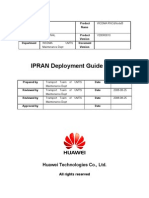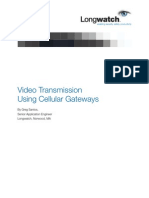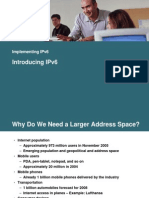0 ratings0% found this document useful (0 votes)
215 viewsWireless Network Security Issues and Solutions
Wireless Network Security Issues and Solutions
Uploaded by
Rutthra ShanmugamWireless networks are popular but lack security, exposing users to risks like eavesdropping, unauthorized access, and denial of service attacks. To address these issues, solutions like encryption, network segmentation, access control, strong authentication, filtering, and ACLs can be applied. While complete security is impossible, adopting best practices can reasonably mitigate risks for most users.
Copyright:
© All Rights Reserved
Available Formats
Download as PPTX, PDF, TXT or read online from Scribd
Wireless Network Security Issues and Solutions
Wireless Network Security Issues and Solutions
Uploaded by
Rutthra Shanmugam0 ratings0% found this document useful (0 votes)
215 views18 pagesWireless networks are popular but lack security, exposing users to risks like eavesdropping, unauthorized access, and denial of service attacks. To address these issues, solutions like encryption, network segmentation, access control, strong authentication, filtering, and ACLs can be applied. While complete security is impossible, adopting best practices can reasonably mitigate risks for most users.
Copyright
© © All Rights Reserved
Available Formats
PPTX, PDF, TXT or read online from Scribd
Share this document
Did you find this document useful?
Is this content inappropriate?
Wireless networks are popular but lack security, exposing users to risks like eavesdropping, unauthorized access, and denial of service attacks. To address these issues, solutions like encryption, network segmentation, access control, strong authentication, filtering, and ACLs can be applied. While complete security is impossible, adopting best practices can reasonably mitigate risks for most users.
Copyright:
© All Rights Reserved
Available Formats
Download as PPTX, PDF, TXT or read online from Scribd
Download as pptx, pdf, or txt
0 ratings0% found this document useful (0 votes)
215 views18 pagesWireless Network Security Issues and Solutions
Wireless Network Security Issues and Solutions
Uploaded by
Rutthra ShanmugamWireless networks are popular but lack security, exposing users to risks like eavesdropping, unauthorized access, and denial of service attacks. To address these issues, solutions like encryption, network segmentation, access control, strong authentication, filtering, and ACLs can be applied. While complete security is impossible, adopting best practices can reasonably mitigate risks for most users.
Copyright:
© All Rights Reserved
Available Formats
Download as PPTX, PDF, TXT or read online from Scribd
Download as pptx, pdf, or txt
You are on page 1of 18
WIRELESS NETWORK
SECURITY ISSUES
AND SOLUTIONS
NAME : RUTTHRA DEVI A/P SHANMUGAM(03DDT17F1066)
: RISHAHTINI A/P MURUGIAH (03DDT17F1086)
CLASS: DDT5C
LECTURER’S NAME : EN. JUSRORIZAL
INTRODUCTION
Wireless network is a network set up by using radio signal
frequency to communicate among computers and other network
devices.
Sometimes it’s also referred to as Wi-Fi network or WLAN.
This network is getting popular nowadays due to easy to setup
feature and no cabling involved.
Wireless security is the prevention of unauthorized access or
damage to computers or data using wireless networks, which
include Wi-Fi networks.
The most common type is Wi-Fi security, which includes Wired
Equivalent Privacy and Wi-Fi Protected Access.
Wireless network security primarily protects a wireless network
from unauthorized and malicious access attempts.
LITERATURE REVIEW
Wireless network is a dynamic research
domain.
WLAN in the areas of quality of service
architecture, admission control, voice and
video streaming, scheduling, bandwidth
allocation and load balancing .
This thesis is concerned with the literature
from the following research domains.
OBJECTIVE
Understand the benefits of a wireless network.
Understand security risks Examples of vulnerabilities
Methods to protect your network
assuring that the information stored in the computer is
never contaminated or changed in a way that is not
appropriate.
keeping information away from people who should not
have it.
Accomplishing this objective requires that we know
what data we are protecting and who should have
access to it.
SECURITY ISSUES
SECURITY ISSUES
1. Traffic analysis
2. Eavesdropping
3. Unauthorized access
4. Denial of Service (DoS)
5. Dictionary-Building Attacks
Traffic analysis
This technique enables the attacker to have the
access to three types of information.
The first type of information is related to
identification of activities on the network.
The second type of information important to the
attacker is identification and physical location of
access point in its surroundings.
The third type of information an attacker can get
by traffic analysis is information about the
communication protocol
Eavesdropping
attacker secretly listens to the private
conversation of others without their
permission.
Eavesdropping attacks include passive
eavesdropping,
Unauthorized access
Once the attacker gets the access to the
network, he is able to initiate some other
types of attacks or use network without being
noticed.
Some can be of an opinion that unauthorized
use of the network is not a significant threat
to the network since the access rights
allocated to resources will disable the
attackers.
Denial of Service (DoS)
An attacker tampers with the data before it is
communicated to the sensor node.
It causes denial of service attack due to wrong
or misleading information.
Jamming is one of DoS attack on network
availability
IP Spoofing
IP Spoofing is a technique used to gain unauthorized
access to machines, whereby an attacker illicitly
impersonates another machine by manipulating IP
packets.
IP Spoofing involves modifying the packet header with
a forged (spoofed) source IP address, a checksum, and
the order value.
Internet is a packet switched network, which causes
the packets leaving one machine may be arriving at the
destination machine in different order.
The receiving machine resembles the message based
on the order value embedded in the IP header.
IP spoofing involves solving the algorithm that is used
SOLUTION
SOLUTIONS-Traffic analysis
Awake Security Platform is a network traffic
analysis solution that focuses on discovering,
assessing, and processing security threats.
The tool is broken down into three parts
Awake Sensors, which continuously monitor
and collect data from devices, apps, and users
Awake Nucleus, which analyzes that data to
understand behaviors and attributes of
entities and applying deep forensics
SOLUTIONS - Eavesdropping
Entertaining encryption strategy will secure you a way out from
eavesdropping. Using encryption measures like digital
certificates will definitely lessen the risk of eavesdropping
attacks.
Apply network segmentation which will prevent eavesdropping
as well as other network attacks.
Employing Network Access Control enhances the security of
your network by checking the authenticity of every device
before establishing any connection
SOLUTIONS- Unauthorized access
Enforce strong authentication strategies.
Keeping usernames and passwords secret
from the unreliable sources.
Not providing unnecessary access to any
user or even to any employee.
SOLUTIONS-Denial of Service (DoS)
1. Contact your Internet Service provider
Notify Internet Service Provider as soon as
possible to determine if your traffic can be rerouted
Having a backup ISP is a good idea, too. Investigate
black hole routing
2. Investigate black hole routing
It directs excessive traffic into a null route,
sometimes referred to as a black hole.
This can help prevent the targeted website or
network from crashing.
SOLUTIONS - IP Spoofing
Filtering of packets entering into the network is one of the
methods of preventing Spoofing.
In other hand, filtering of incoming and outgoing traffic
should also be implemented.
ACLs helps prevent Spoofing by not allowing falsified IP
addresses to enter.
Accreditation to encryption should be provided in order to
allow only trusted hosts to communicate with.
SSL certificates should be used to reduce the risk of
spoofing at a greater extent.
CONCLUSION
In conclusion, nothing is absolutely secure. It is up to you to
determine what your acceptable level of risks is and
how/when to mitigate them as well as when to deviate from
this. I hope this post has scared you a little about using public
or retail store Wi-Fi as well as Wi-Fi in hotels and other public
places. While the likelihood of you being targeted varies upon
who you are and where you are, generally, people are only
targeted in evil twin type attacks. I would be concerned if I
saw several cars parked on the streets in front of your house
late at night. You may want to change your wireless password,
review your encryption type, and relocate the antenna
You might also like
- Wi-Fi Security: Canadian Institute of Technology (Cit)Document11 pagesWi-Fi Security: Canadian Institute of Technology (Cit)Bum MusicNo ratings yet
- 13 5Document5 pages13 5jaiganeshv1991No ratings yet
- FCGA Definition of Terms - Revisions2017 PDFDocument9 pagesFCGA Definition of Terms - Revisions2017 PDFDiego ZABALANo ratings yet
- OneWireless Sample Site Survey ReportDocument31 pagesOneWireless Sample Site Survey ReportMichell AntunesNo ratings yet
- V Unit - Wireless Network SecurityDocument22 pagesV Unit - Wireless Network SecurityBRINDHA C it2018No ratings yet
- Wi-Fi - Quick Guide What Is Wi-Fi ?Document6 pagesWi-Fi - Quick Guide What Is Wi-Fi ?Anbazhagan SelvanathanNo ratings yet
- Hotel WiFi BriefDocument2 pagesHotel WiFi BriefrcityNo ratings yet
- Huawei Indoor Digitalization The Road To 5G Marco Xu-20190408 VFDocument23 pagesHuawei Indoor Digitalization The Road To 5G Marco Xu-20190408 VFRoberto TR100% (1)
- Altai Super WiFi For Island Resort Wireless Internet Access in A Malaysian Rainforest EnvironmentDocument2 pagesAltai Super WiFi For Island Resort Wireless Internet Access in A Malaysian Rainforest EnvironmentajdCruiseNo ratings yet
- NSW Telecommunications Facilities Guideline Including BroadbandDocument40 pagesNSW Telecommunications Facilities Guideline Including BroadbandDiniNo ratings yet
- Huawei WLAN Products Pre-Sales TrainingDocument63 pagesHuawei WLAN Products Pre-Sales TrainingAbdelilah CharboubNo ratings yet
- Industry Based Wifi TrainingDocument8 pagesIndustry Based Wifi TrainingzulkipliyaacobNo ratings yet
- A Very Good WiFi APs Stress Test Report PDFDocument70 pagesA Very Good WiFi APs Stress Test Report PDFkflimNo ratings yet
- SenzaFili IntelTB Wi Fi7 The Next Generation in The Evolution of Wi FiDocument9 pagesSenzaFili IntelTB Wi Fi7 The Next Generation in The Evolution of Wi Fiaa medooNo ratings yet
- IPRAN Deployment Guide V210-20090303Document132 pagesIPRAN Deployment Guide V210-20090303UsersNo ratings yet
- Huawei WLAN Products and SolutionDocument57 pagesHuawei WLAN Products and SolutionPt sinergi teknologi BersatuNo ratings yet
- Ranplan Apac Why Dec18Document26 pagesRanplan Apac Why Dec18Vikas KumarNo ratings yet
- WIFI-Based Indoor Positioning SystemDocument3 pagesWIFI-Based Indoor Positioning SystemKitsayakorn Chantanasawee100% (1)
- DSLDocument27 pagesDSLgaurav_juneja_4No ratings yet
- GSMA-5G SA Option 2 Implementation Guideline v1.3Document47 pagesGSMA-5G SA Option 2 Implementation Guideline v1.3MatthewNo ratings yet
- The Basics of FTTHDocument36 pagesThe Basics of FTTHFanny Tampubolon100% (1)
- WiFi SecurityDocument11 pagesWiFi SecurityAyeshaZohraaNo ratings yet
- DatasheetDocument2 pagesDatasheetIhab A Osman100% (1)
- Wi-Fi TestingDocument4 pagesWi-Fi TestingRaja PrabuNo ratings yet
- HCIE-WLAN V1.0 Training MaterialDocument1,334 pagesHCIE-WLAN V1.0 Training Materialyingkitcheung001No ratings yet
- Ekahau Sidekick Accuracy - Final3 PDFDocument21 pagesEkahau Sidekick Accuracy - Final3 PDFEdi SantosoNo ratings yet
- Wi-Fi 802.11 Standard SecurityDocument22 pagesWi-Fi 802.11 Standard SecurityAbdul HameedNo ratings yet
- IBW Best Practices Ebook CO-110744-EnDocument55 pagesIBW Best Practices Ebook CO-110744-EnzacgNo ratings yet
- School District of Palm Beach CountyDocument5 pagesSchool District of Palm Beach CountyXandra LeeNo ratings yet
- Hotel Basic Network Configuration - PNPDocument12 pagesHotel Basic Network Configuration - PNPAndi Eky Rezky AtmuldinNo ratings yet
- Malaysia Rear Seatbelt CampaignDocument7 pagesMalaysia Rear Seatbelt Campaignsathiyaa80% (1)
- Wireless Standards Wi Fi 6 Evolution and Wi Fi 7Document5 pagesWireless Standards Wi Fi 6 Evolution and Wi Fi 7Editor IJTSRDNo ratings yet
- Wi-Fi Offload Mechanisms For NetworksDocument10 pagesWi-Fi Offload Mechanisms For NetworksHarish VadadaNo ratings yet
- Huawei Wi-Fi 6 METODOLOGIA (IEEE 802.11ax) Technology White PaperDocument29 pagesHuawei Wi-Fi 6 METODOLOGIA (IEEE 802.11ax) Technology White PaperLeidy ChNo ratings yet
- Cisco Catalyst 9115 Series Wi-Fi 6 Access Points: Data SheetDocument33 pagesCisco Catalyst 9115 Series Wi-Fi 6 Access Points: Data Sheetbonsai todayNo ratings yet
- Simulation of Manet Routing Algorithm: Under The Guidance Of: P. Ramya SruthiDocument20 pagesSimulation of Manet Routing Algorithm: Under The Guidance Of: P. Ramya Sruthipandu_harshaNo ratings yet
- Things To Know About Wifi6Document1 pageThings To Know About Wifi6NehaNo ratings yet
- Description of WiFi Services-DesignDocument5 pagesDescription of WiFi Services-DesignshindeleNo ratings yet
- Types of Broadband AccessDocument39 pagesTypes of Broadband AccessmasangkayNo ratings yet
- 802.11ac: The Fifth Generation of Wi-Fi: Technical White PaperDocument20 pages802.11ac: The Fifth Generation of Wi-Fi: Technical White PaperchopanalvarezNo ratings yet
- NBN Co Network Design RulesDocument50 pagesNBN Co Network Design Rulesmisr1972No ratings yet
- Chapter 5Document16 pagesChapter 5Hina SaeedNo ratings yet
- Design and Implementation of A WiFi Based Home Automation SystemDocument7 pagesDesign and Implementation of A WiFi Based Home Automation SystemVenky VenkateshNo ratings yet
- 10 Huawei Campus OptiX Solution Network Design and Quatation - EN v1.1Document48 pages10 Huawei Campus OptiX Solution Network Design and Quatation - EN v1.1Luis RodriguezNo ratings yet
- Issi-Cssi Primer Final 508cDocument15 pagesIssi-Cssi Primer Final 508cAndrea Fox100% (1)
- Spatialnet: End-To-End Physical Network Inventory ManagementDocument3 pagesSpatialnet: End-To-End Physical Network Inventory ManagementtalhaNo ratings yet
- Cloud4Wi - Solution BriefDocument25 pagesCloud4Wi - Solution BriefSureSh FreemanNo ratings yet
- Introduction To BroadbandDocument7 pagesIntroduction To BroadbandAbhishek DebNo ratings yet
- TETRA Solutions BR-102188Document4 pagesTETRA Solutions BR-102188Sulaiman HasanNo ratings yet
- Multiple Access Schemes FDMA TDMA CDMA For ClassDocument26 pagesMultiple Access Schemes FDMA TDMA CDMA For Classmuhammad yaseenNo ratings yet
- Wi Fi 6 - White PaperDocument21 pagesWi Fi 6 - White PaperĐinh Nhất LinhNo ratings yet
- Video Transmission Using Cellular Gateways: by Greg Santos, Senior Application Engineer Longwatch, Norwood, MADocument11 pagesVideo Transmission Using Cellular Gateways: by Greg Santos, Senior Application Engineer Longwatch, Norwood, MAarteepu4No ratings yet
- BSCI30S08 IPv6Document73 pagesBSCI30S08 IPv6Fabio QuintanaNo ratings yet
- Hotel Wi-FiDocument9 pagesHotel Wi-FiSujit KumarNo ratings yet
- Evolution of Wireless Networks (Part III)Document30 pagesEvolution of Wireless Networks (Part III)Shakeel AminNo ratings yet
- Apresentacao Cisco NCSDocument63 pagesApresentacao Cisco NCSTiago ZacariasNo ratings yet
- Moxa White Paper Turbo RoamingDocument9 pagesMoxa White Paper Turbo RoamingNBPatNo ratings yet
- What's The Difference Between IEEE 802.11ah and 802.11af in The IoTDocument3 pagesWhat's The Difference Between IEEE 802.11ah and 802.11af in The IoTMiguel LiceagaNo ratings yet
- Ise V Database Management Systems (10cs54) SolutionDocument89 pagesIse V Database Management Systems (10cs54) Solutionsscr27No ratings yet
- Catheterization of The Urinary Bladder (Foley Catheterization)Document8 pagesCatheterization of The Urinary Bladder (Foley Catheterization)Ilie DanielaNo ratings yet
- Sin ListDocument42 pagesSin Listanon_252430020No ratings yet
- Difference Between The Communication and TransmissionDocument33 pagesDifference Between The Communication and TransmissionvineetsudevNo ratings yet
- Anticoagulant Mcqs ExplainedDocument3 pagesAnticoagulant Mcqs ExplainedHawi BefekaduNo ratings yet
- 6th June 2011 - 21Document17 pages6th June 2011 - 21Wilfred DsouzaNo ratings yet
- Class 8 EnglishDocument5 pagesClass 8 Englishgobindaspkota50No ratings yet
- A History of AstronomyDocument10 pagesA History of AstronomyHadi Bangash100% (1)
- iogi2018,+Christheo+M.+Mamangkey+11Document10 pagesiogi2018,+Christheo+M.+Mamangkey+11francescosinagaNo ratings yet
- CASE 3: Vans: Skating On Air: Product and Brand ManagementDocument4 pagesCASE 3: Vans: Skating On Air: Product and Brand ManagementMalini RajashekaranNo ratings yet
- 48 Republic Vs CA and LastimadoDocument8 pages48 Republic Vs CA and LastimadocharmssatellNo ratings yet
- Trueayurveda Wordpress Com 2013 01 13 Difference Between YogDocument11 pagesTrueayurveda Wordpress Com 2013 01 13 Difference Between YogAswadh AswadhNo ratings yet
- Cohn (1997) Existential Thought and Therapeutic Practice. An Introduction To Existential Psychotherapy (CAP 2)Document12 pagesCohn (1997) Existential Thought and Therapeutic Practice. An Introduction To Existential Psychotherapy (CAP 2)Marcela Castro BecerraNo ratings yet
- PP Vs Solis PDFDocument15 pagesPP Vs Solis PDFOlivia JaneNo ratings yet
- MASTER CADRE ENGLISH MCQ-4Document4 pagesMASTER CADRE ENGLISH MCQ-4braveamankumarNo ratings yet
- TR 3957 Netapp Media Content Management SolutionDocument13 pagesTR 3957 Netapp Media Content Management Solutionfly4phunNo ratings yet
- Industrial Fluid PowerDocument6 pagesIndustrial Fluid PowerSumit GawareNo ratings yet
- Cetrorelix Drug StudyDocument2 pagesCetrorelix Drug Studyhappymee927No ratings yet
- 2C/Temp-Rh: Marathon ProductsDocument2 pages2C/Temp-Rh: Marathon ProductsiliyasNo ratings yet
- Unit - I: Question BankDocument25 pagesUnit - I: Question BankJanardhan ChNo ratings yet
- Assignment SociolinguisticDocument4 pagesAssignment SociolinguisticNik Muhammad FadleyNo ratings yet
- OrdjudDocument2 pagesOrdjudKomal PatilNo ratings yet
- Price of PluralityDocument224 pagesPrice of PluralityDiego García RamírezNo ratings yet
- Levy JesuitVisualCultureDocument22 pagesLevy JesuitVisualCultureluisNo ratings yet
- Bracing System in BuildingDocument23 pagesBracing System in BuildingSouhard MatreNo ratings yet
- C Senior Auditor Recruitment Test Guide Dogar Unique Part-1Document147 pagesC Senior Auditor Recruitment Test Guide Dogar Unique Part-1kawi MNo ratings yet
- Pre-Arrest (Azhar Shah)Document5 pagesPre-Arrest (Azhar Shah)api-3745637No ratings yet
- Courage and Character, Leaders and Legends: An Interview With Richard LowerDocument2 pagesCourage and Character, Leaders and Legends: An Interview With Richard LowerAli RajaNo ratings yet
- Read The Letter Carefully and Answer QuestionsDocument2 pagesRead The Letter Carefully and Answer QuestionsLETCHUMY A/P MARIPAN MoeNo ratings yet
- Senior 6 - Grammar RevisionDocument4 pagesSenior 6 - Grammar RevisionnadiaNo ratings yet

























































































